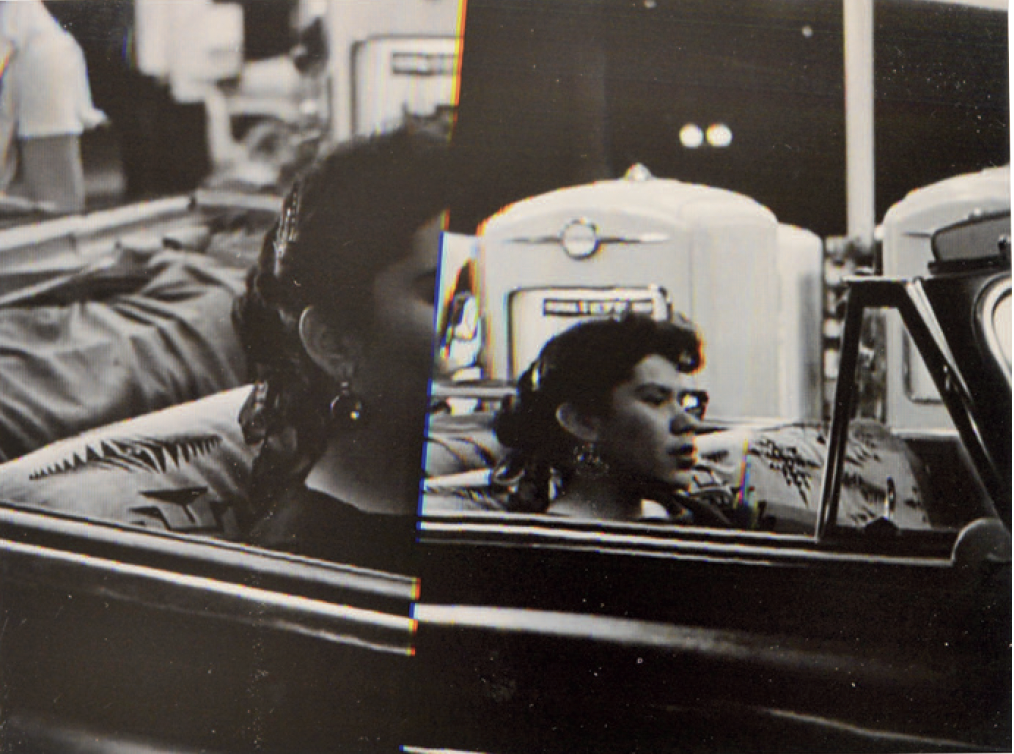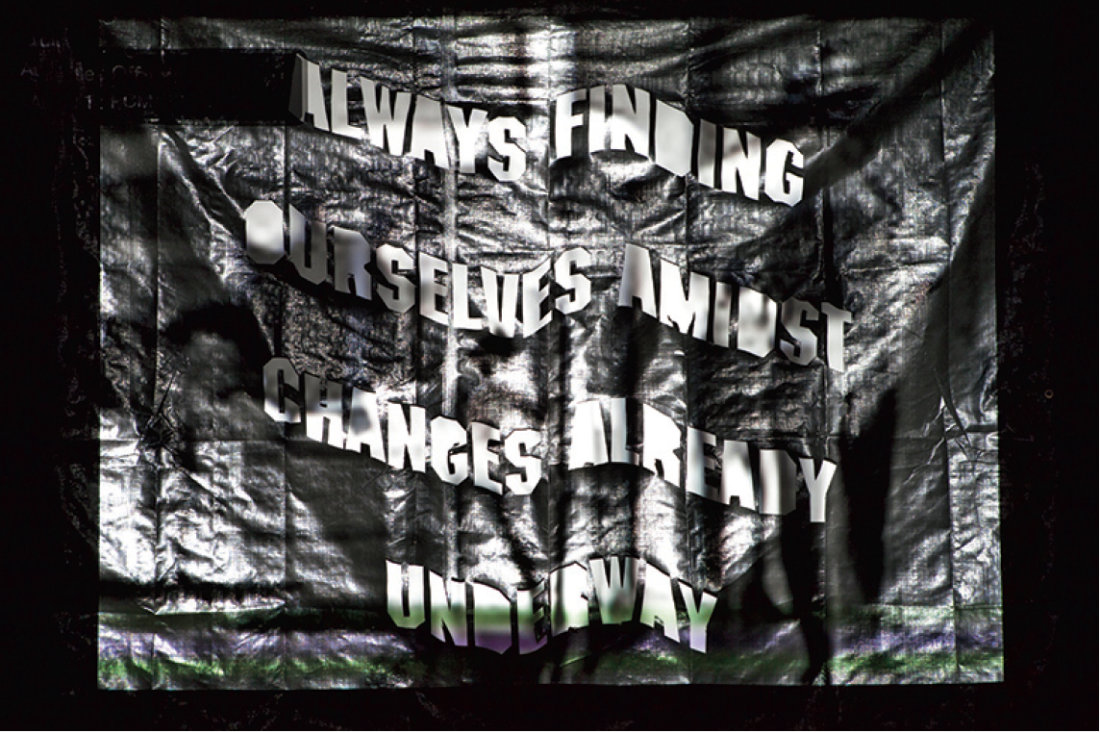Raymond Boisjoly
How can we come to see ourselves, our culture, when everything is always in the process of becoming something else? What does it mean to be Indigenous to a place, when all places are in a constant state of transformation?
These were the central questions posed by Vancouver-based artist Raymond Boisjoly’s concurrent exhibitions at two Winnipeg artist-run centres, and they’re good ones to ask in Canada right now. Urban Shaman and PLATFORM hosted distinct but related exhibitions, respectively titled “Silent Trans-Forming” and “Station to Station.” Boisjoly, who is of Haida and Québécois descent, has been gaining recognition recently for smart, slick work that investigates language, technology and indigeneity in popular culture past and present.
Like many contemporary artists, Boisjoly is a finder as much as a maker, using the Internet to uncover fragments of the past that might say something about the way we live now. He collects moments of Indigenous participation in North American popular culture, and his Winnipeg exhibitions both involved the re-presentation of digitally-sourced black and white footage from the 1960s.

Raymond Boisjoly, from “Station to Station,” 2014, PLATFORM centre for photographic + digital arts, lightjet printed, mounted on dibond, 18 x 24 inches. Courtesy Catriona Jeffries Gallery, Vancouver and Platform, Winnipeg.
In “Silent Trans-Forming,” Boisjoly’s starting point was a YouTube clip of Pat and Lolly Vegas performing Write me, baby in 1965. The Vegas brothers (born Vasquez) were a surf-pop duo of Yaqui, Shoshon and Mexican heritage, who eventually went on to form the innovative rock band Redbone. As Redbone, they foregrounded their Indigenous identities, often performing in full pow-wow regalia and releasing albums with titles like Potlatch and We Were All Wounded At Wounded Knee. But the video for Write me, baby captures an earlier, less overtly politicized moment, when the brothers were still short haired and sharp suited, snapping their fingers and crooning to a surf-pop beat.
In “Silent Trans-Forming,” Boisjoly has muted the sound and projected the low-resolution video onto a crinkly black tarp, making it difficult, though not impossible, to interpret the moving images. Large block letters have been sliced out of the tarp, forming the phrase “ALWAYS FINDING OURSELVES AMIDST CHANGES ALREADY UNDERWAY.” It is possible to read this as an expression of forlorn bewilderment, as the Vegas brothers (or Indigenous peoples, or all people) are swept along by transformative forces beyond their control. But a shift in emphasis suggests a less fatalistic interpretation: that they, or we, are always finding ourselves through this process of change—that a state of flux is the necessary condition for self-discovery. Rather than defining itself solely in relation to a fixed notion of tradition, this piece suggests that Indigenous self-understanding could equally be established through a flexible and adaptive sense of cultural identity.
Boisjoly returns to the shifting youth culture of the 1960s in “Station to Station.” Here, his work engages with Kent McKenzie’s 1961 film The Exiles, an experimental documentary that follows a group of Indigenous young people living in Los Angeles. Boisjoly scanned the movie while streaming it on an iPad, leading to a series of photographic prints. In this process, the scanner struggles with the moving picture, capturing some slices of clear imagery but converting other information into wavy rainbow-coloured glitches. These weirdly celebratory interruptions of legibility act in counterpoint to the moody black and white glimpses of the film’s stars. The scanned pictures are all culled from the same scene, in which a gang of friends stops to refuel at a gas station midway through a night of flirting, fighting, drinking and dancing.

Silent Trans-Forming, 2012, silent standard definition projection on modified tarpaulin, 2:12. Photograph: Karen Asher. Courtesy Catriona Jeffries Gallery and Urban Shaman Gallery, Winnipeg.
Gas stations are a recurring motif in Boisjoly’s work, and their symbolic importance is emphasized by the title of this exhibition. The station is a place of pause, but it’s a stop that has to be made in order to fuel the next stage of a journey. In “Station to Station,” the scanner creates still images even as the film plays onward, making each picture both a station and part of a trip. The work suggests that the past is a still and moving thing, never fully seen, never adequately represented.
Boisjoly’s exhibitions address the limits of legibility, the difficulty of representation, the slipperiness of identity. His work is well thought out, stylish and professional. I wish it were a little less so. There is something airless in this art that talks about failed vision without really risking it; that points to illegibility with such clarity and precision. The aesthetic strategies of Boisjoly’s work—the smooth, perfect prints of digital glitches, the trendy use of vernacular materials, the tastefully consistent colour palette—are much less adventurous than his ideas.
This is not a fatal flaw. Boisjoly’s research interests are compelling enough to make engaging with his work worth your while. This is art that understands itself as being part of a difficult and important conversation, and as such, feels the necessity of speaking clearly, even—or perhaps especially—when addressing the limits of representation and the inscrutability of identity. The pressure not to say the wrong thing has a tendency to clean up the rough edges of art, and although discursive precision and conceptual clarity are valuable, every once in a while artists need to give themselves the space to get muddled up and mysterious—that’s what keeps art from professionalizing itself to death. But who knows: in the studio, only the artist can hear rumblings of the work to come. I hope Boisjoly’s practice becomes a little wilder, riskier, less strategic; it is entirely possible that those changes are already underway. ❚
“Silent Trans-Forming” was exhibited at Urban Shaman Gallery, Winnipeg from April 4 to June 7, 2014; “Station to Station” was exhibited at PLATFORM, Winnipeg from April 4 to May 17, 2014.
Erica Mendritzki is an artist and educator living in Winnipeg.

